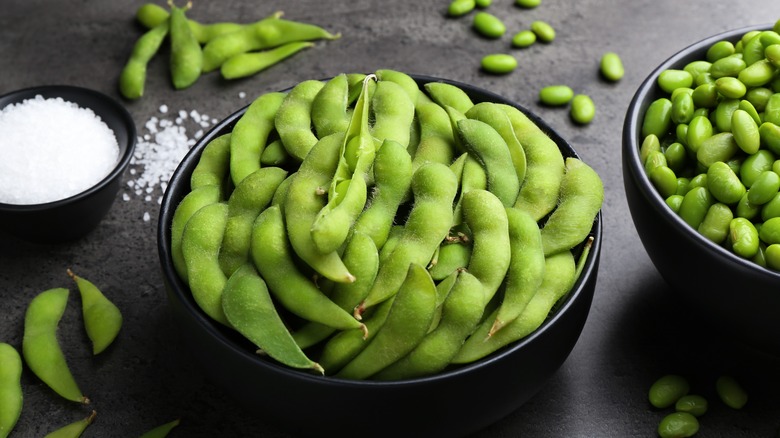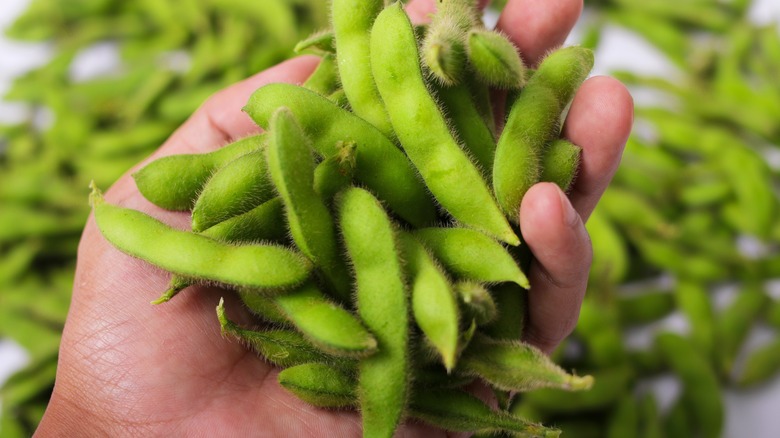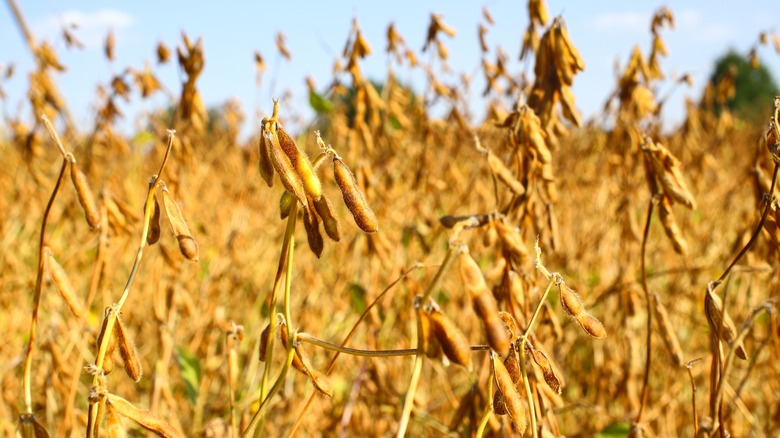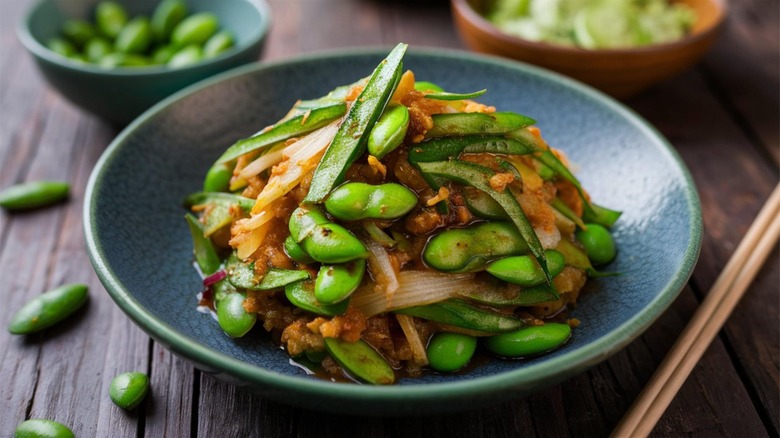Are Soybeans And Edamame The Same Thing?
We may receive a commission on purchases made from links.
What tortilla chips are to a Mexican restaurant, edamame is to a Japanese restaurant. Served alongside a drink or before dinner, it's the salty snack you keep reaching for. Unlike tortilla chips, though, edamame is made of vegetables — each pod has two or three beans, like peas. In fact they're soybeans, right? At least that's what we've always been told — but is it true?
The answer is that edamame is a specific kind of soybean. In particular, it's a variety harvested while still immature. The beans are boiled or steamed in the pods, often with salt, and served warm or cool. Pop them out of their shells and into your mouth for a perfect balance of firm and fleshy, with a hint of salt and sweet and a nutty astringency. They are also shelled and added to rice bowls, salads, ramen, and other dishes. They're so good, it makes one wonder why all soybeans aren't served the same way. But while regular soybean is a major food crop for both humans and livestock, edamame varieties are considered a minor one globally, with most consumption happening throughout East Asia.
What makes a soybean edamame
Edamame is considered a vegetable soybean as opposed to "field" or "grain" types. The whole plant is harvested young and green (regular soy dries out in the crops to be processed later). They were first recorded in China as a medicinal plant — under the name "mao dou" — around 200 B.C. By A.D. 927, they were referred to as "aomame" in Japan, and they were specifically identified as edamame as early as A.D. 1275.
So is edamame just young soybean? Sort of. But it's a specific variety, with key differences from the much more common grain soy. According to the "History of Edamame, Vegetable Soybeans, and Vegetable-Type Soybeans," vegetable soybeans are "harvested at the fresh green stage," before they mature and dry. In Japan, they are often harvested by hand and sold on the stem (edamame is a Japanese word that translates to "stem bean"). Though they originated in East Asia, vegetable soybeans grow well around the world.
Harvested early, the plants are more digestible and contain more vitamins and fewer trypsin-inhibitors than mature grain soy plants, meaning they are tastier and less gassy. Edamame beans are also larger than their grain soy counterparts and have a sweet-and-nutty taste as opposed to the brash bean flavor of regular soybeans. Finally, edamame is generally bright green in color where grain soy pods are a pale yellow. Interestingly, when the color is brightest and the beans are at their ideal size, the flavor has already begun dissipating as sugar content decreases. Thus timing the harvest is essential for the best edamame.
Grain soybeans dry out in the fields
Most soy-based products are made from the smaller-beaned grain varieties. Like wheat, it stands in the field until pods and beans are dry on the stalks. Soybeans are thought to have originated in China thousands of years ago. Where vegetable soybeans are harvested immature — between about 75 and 100 days after planting — grain soybeans are left to grow up to about 130 days. The exact time depends on the season's temperature and day length (longer days delay flowering).
Grain soybeans are an excellent source of protein, but the dried beans are not particularly edible on their own, so we grind and process them to be used for tofu, bean pastes, animal feed, and as a texturizing ingredient. Soy is an endlessly versatile legume, related to other hearty beans like kidney and pinto, along with peas and chickpeas. As such, dried yellow soybeans are used in soups and salads, to make soy milk, and as a meat replacement. But they must be properly cooked for up to six hours to ease digestion. There's no quick-steaming grain or yellow varieties! In Japan, grain soybeans are also used in making natto, a fermented Japanese breakfast dish (some might call it an acquired taste).
Other ways to enjoy edamame beans
Steaming the beans to enjoy straight from the pods or shelling them for salads and colorful poke bowls are probably the most popular ways of preparing edamame, but there are a number of other delicious options. In Japan, the beans are ground and mixed with miso to make a thick and umami/nutty soup broth. Throughout Southeast Asia, you'll find snacks made with walnuts, edamame, and a sweetener like honey or molasses (it's gaining popularity in the U.S. as well). Or pick up a bag of dry-roasted edamame. They're generally an excellent choice for those pursuing a vegan or gluten-free diet (but always check the ingredients of any new package), or as a replacement for potato chips.
There's no reason to limit enjoyment of edamame to common or traditional dishes. Keep a bag in the freezer and use them as a replacement for kidney or navy beans. Try them in a three-bean vegetarian chili or succotash. Mash with garlic and lemon juice to create a sort of edamame hummus. Or coat dry roasted beans with melted dark chocolate to recreate a bittersweet, discontinued Trader Joe's treat. There are so many possibilities!



